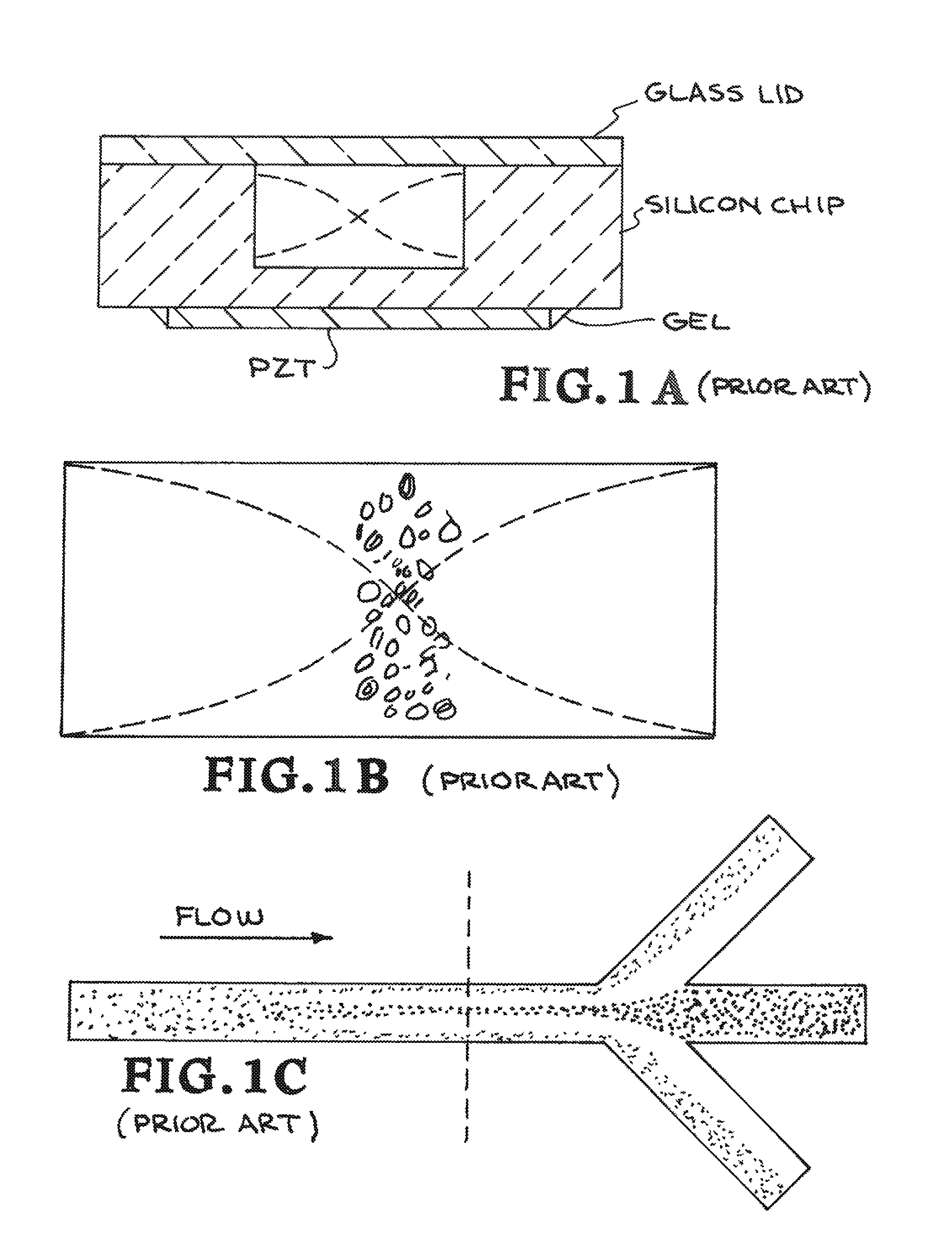Microfluidic ultrasonic particle separators with engineered node locations and geometries
a technology of microfluidic ultrasonic particle separator and engineered node location, which is applied in the direction of separation process, laboratory glassware, instruments, etc., can solve the problems of limited mixing, achieve greater purity, improve separation, and optimize the pressure field resulting from acoustic waves
- Summary
- Abstract
- Description
- Claims
- Application Information
AI Technical Summary
Benefits of technology
Problems solved by technology
Method used
Image
Examples
example 1
[0026]Referring now to the drawings and in particular to FIG. 2A, one embodiment of the present invention is illustrated.
[0027]The device uses multiple microfluidic channels running in parallel along the length of a microfluidic chip, separated by specifically-designed distances (the “wall thickness”). One of these multiple channels serves as the separation channel and has two inlets and two outlets. The ultrasound standing-wave pressure fields are optimized to transfer focused particles out of the sample stream and into the recovery fluid within the recovery fluid channel. The piezoelectric transducer may be driven at single or multiple frequencies to achieve the optimal node placement depending on the channel and wall geometry. In addition, multiple small piezoelectric transducers may be arranged to produce different sound fields in different regions of the chip.
[0028]The present invention provides an ultrasonic microfluidic system for separating smaller particle...
example 2
Two Node System
[0034]Referring now to FIG. 3A, another embodiment of the present invention is illustrated. The device uses multiple microfluidic channels running in parallel along the length of a microfluidic chip 316, separated by specifically-designed distances (the “wall thickness”). One of these multiple channels serves as the separation channel and has two inlets and two outlets. The ultrasound standing-wave pressure fields are optimized to transfer focused particles out of the sample stream and into the adjacent recovery fluid stream, which flow together down the separation channel. The piezoelectric transducer 314 may be driven at single or multiple frequencies to achieve the optimal node placement depending on the channel and wall geometry. In addition, multiple small piezoelectric transducers may be arranged to produce different sound fields in different regions of the chip.
[0035]The present invention provides an ultrasonic microfluidic system for separating smaller particl...
example 3
Alternative Fluid Channel Layout
[0042]Referring now to the drawings and in particular to FIG. 4A, another embodiment of the present invention is illustrated. The device uses multiple microfluidic channels running in parallel along the length of a microfluidic chip, separated by specifically-designed distances (the “wall thickness”). One of these multiple channels serves as the separation channel and has two inlets and two outlets. The ultrasound standing-wave pressure fields are optimized to transfer focused particles out of the sample stream and into the recovery fluid within the recovery fluid channel. The piezoelectric transducer may be driven at single or multiple frequencies to achieve the optimal node placement depending on the channel and wall geometry. In addition, multiple small piezoelectric transducers may be arranged to produce different sound fields indifferent regions of the chip.
[0043]The embodiment illustrated in FIG. 4A is designated generally by the reference numer...
PUM
| Property | Measurement | Unit |
|---|---|---|
| diameter | aaaaa | aaaaa |
| depth | aaaaa | aaaaa |
| thickness | aaaaa | aaaaa |
Abstract
Description
Claims
Application Information
 Login to View More
Login to View More - R&D
- Intellectual Property
- Life Sciences
- Materials
- Tech Scout
- Unparalleled Data Quality
- Higher Quality Content
- 60% Fewer Hallucinations
Browse by: Latest US Patents, China's latest patents, Technical Efficacy Thesaurus, Application Domain, Technology Topic, Popular Technical Reports.
© 2025 PatSnap. All rights reserved.Legal|Privacy policy|Modern Slavery Act Transparency Statement|Sitemap|About US| Contact US: help@patsnap.com



